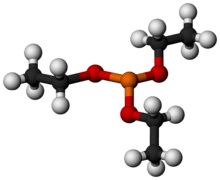Triethyl phosphite
Triethyl phosphite is an organophosphorus compound with the formula P(OCH2CH3)3, often abbreviated P(OEt)3. It is a colorless, malodorous liquid. It is used as a ligand in organometallic chemistry and as a reagent in organic synthesis
 | |
3.png) | |
| Names | |
|---|---|
| IUPAC name
Triethyl phosphite | |
| Other names
Triethoxyphosphine | |
| Identifiers | |
3D model (JSmol) |
|
| ChemSpider | |
| ECHA InfoCard | 100.004.139 |
PubChem CID |
|
| UNII | |
CompTox Dashboard (EPA) |
|
| |
| |
| Properties | |
| C6H15O3P | |
| Molar mass | 166.157 g·mol−1 |
| Appearance | colorless liquid |
| Density | 0.969 g/mL |
| Melting point | −70 °C (−94 °F; 203 K) |
| Boiling point | 156 °C (313 °F; 429 K) (57 to 58 °C at 16 mm) |
| organic solvents | |
| -104.8·10−6 cm3/mol | |
| Hazards | |
| Main hazards | toxic |
Except where otherwise noted, data are given for materials in their standard state (at 25 °C [77 °F], 100 kPa). | |
| Infobox references | |
The molecule features a pyramidal phosphorus(III) center bound to three ethoxide groups. Its 31P NMR spectrum features a signal at around +139 ppm vs phosphoric acid standard.
Triethylphosphite is prepared by treating phosphorus trichloride with ethanol in the presence of a base, typically a tertiary amine:[1]
- PCl3 + 3 EtOH + 3 R3N → P(OEt)3 + 3 R3NH + Cl−
In the absence of the base, the reaction affords diethylphosphite ((EtO)2P(O)H). Of the many related compounds can be prepared similarly, triisopropyl phosphite is an example (b.p. 43.5 °C/1.0 mm; CAS# 116-17-6).
As a ligand
In coordination chemistry and homogeneous catalysis, triethylphosphite finds use as a soft ligand. Its complexes are generally lipophilic and feature metals in low oxidation states. Examples include the colorless complexes FeH2(P(OEt)3)4 and Ni(P(OEt)3)4 (m.p. 187 °C).[2]
References
- Ford-Moore, A. H.; Perry, B. J. (1951). "Triethyl Phosphite". Org. Synth. 31: 111. doi:10.15227/orgsyn.031.0111.
- Ittel, Steven D. (1990). "Complexes of Nickel(0)". Inorganic Syntheses. 28: 98–104. doi:10.1002/9780470132593.ch26. ISBN 978-0-470-13259-3.